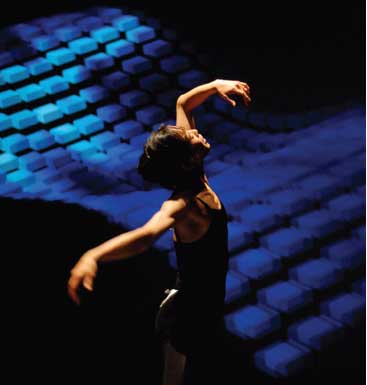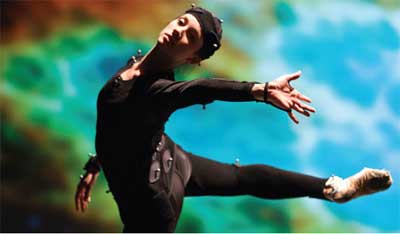 Introduction
Introduction
The Deakin Motion.Lab is a centre for creative research into technology and performance, as well as movement analysis of physically demanding professions such as dance and sport. The centre also teaches motion capture within Deakin University’s animation program, and provides commercial motion capture services to industry. The Deakin Motion.Lab worked with the Melbourne Ballet Company to develop a ground breaking world premiere dance performance named Choreotopography, created using Autodesk software.
Each dancer was dressed in a motion capture suit and his/her movements were captured, using Autodesk MotionBuilder software, and used to create real-time motion graphics using Autodesk Maya software. Wearing 3D glasses, the audience saw 3D stereoscopic images projected around the dancers and into the audience; expanding the dancers’ presence on stage and making them appear to dance in computer generated landscapes.Bringing two worlds together
The Deakin Motion.Lab had an extremely tight timeline in which to deliver the performance for public viewing. The team had around two months to execute the project from concept to production. During this period, the Deakin Motion.Lab team only had a limited number of test sessions in their studio with the ballet dancers. Working with the dancers added other complexities to the tests.
“It was important that the dancers weren’t left waiting around for too long whilst we calibrated and tweaked the system, as cold muscles could result in a strain or other injury,” explained Dr. Kim Vincs, Director, Deakin Motion.Lab.Once the testing was completed, the Deakin Motion.Lab only had one and a half days in December ahead of the performance to transfer the motion capture and stereo projection set up from the Studio into the Arts Centre Theatre.
With limited time to set the system up the team had no room for errors. The team also had to appreciate that the dancers are more flexible than usual motion capture performers so the team had to plan for instances where motion capture markers may be blocked from the cameras as the dancers moved around the stage. When setting up the system the team had to consider the audience’s experience.
Projecting onto the screen, and with stereoscopic 3D projections appearing around the dancers, the team needed to make sure that the experience was consistent for audience members no matter which seat they occupied within the 850 seat auditorium. Autodesk delivers performance
Autodesk delivers performance
Deakin University has a rich history of working with Autodesk products for both teaching and research projects. The team started using Autodesk products in the 2004/2005 academic year, and the recent focus has been working with Maya and MotionBuilder.
The systems behind this project had been in development since 2007, when the team created a live motion capture performance pipeline.
In 2009, they commenced studio testing of a stereo-projection system using MotionBuilder linked to the live motion capture system. The live motion capture and stereo-projection systems then formed the basis of the technology for the dance performance. The Deakin Motion.Lab’s real-time motion capture system captured data and transferred it to MotionBuilder, which then integrated 3D imagery and animations created in Maya, ready for stereoscopic projection.
 Autodesk solutions bring the show to life
Autodesk solutions bring the show to life
One of the main benefits that helped the Deakin Motion.Lab deliver the project within a tight timeline was the interoperability of Maya and MotionBuilder, using Autodesk FBX asset exchange technology. “Without the luxury of time we couldn’t sit around waiting for data to convert as we moved from one program to the other.
Being able to work seamlessly between Maya and MotionBuilder meant that the timeline was realistic. The Autodesk software really was the fastest way for us to prototype ideas,” commented Dr. Kim Vincs, Director, Deakin Motion Lab.It was important that the Deakin Motion.Lab was able to update the system quickly during rehearsals to avoid having the dancers standing around waiting. In the studio, the power of Maya and MotionBuilder enabled the team to make changes instantaneously as they experimented to maximize the audience’s experience. The speed of Autodesk solutions enabled the team to focus on creating visually stunning animations and movements, rather than managing software functionality. The speed of system and software updates was also important when the team came to set up in the theatre.
Autodesk MotionBuilder enabled the team to develop a range of contingencies such as this to allow for a smooth and seamless performance. MotionBuilder also provided the team with controllable stereoscopic parameters used for the performances. “We were conscious that we didn’t want to create too big a leap for the audience, so it was great to have the control over the depth of the stereoscopic projection so that we could create a comfortable experience for the audience,” explained Dr. Kim Vincs, Director, Deakin Motion.Lab.
Autodesk solutions bring the show to life
The performance was well received, with audiences and media expressing their enjoyment of the display. “We were really pleased with the results. We have received some great recognition in the industry and we have been invited to apply for a range of interactive arts grants based on the work we have completed,” says Dr. Kim Vincs, Director, Deakin Motion.Lab. This project proved to the team and the industry that live motion capture and stereoscopic projection isn’t cost prohibitive and can be set up under tight timelines. “We are looking forward to taking this program to the next level and the power of Autodesk software is going to be a key driver as we progress,” concludes Dr. Kim Vincs, Director, Deakin Motion.Lab.connect@animationxpress.com

